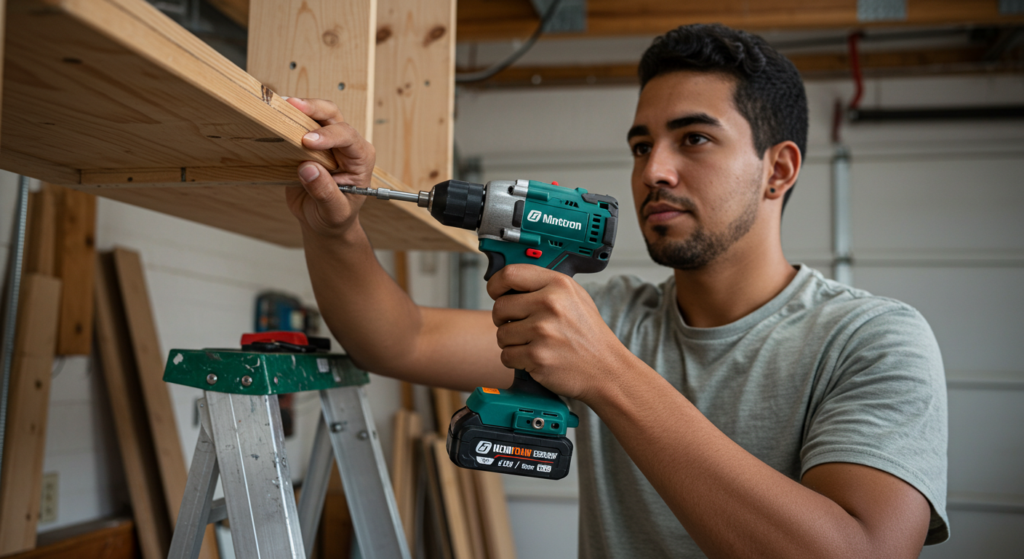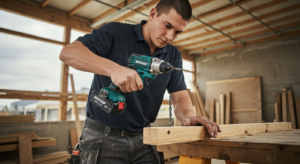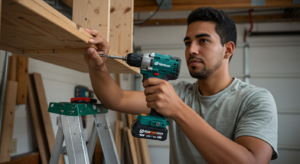Cordless Impact Drivers: Buyers Guide

A person in a gray t-shirt uses a cordless power drill to secure a screw into a piece of wood in a workshop, with a ladder and garage door in the background.
Best Cordless Impact Drivers: 2025 Buyer’s Guide
Table of Contents
Introduction to Cordless Impact Drivers
The best cordless impact drivers make DIY and pro projects a breeze in 2025. For instance, these tools come in powerful 18V impact driver models or handy compact impact driver designs. They use a mix of spinning and tapping to drive screws and bolts fast. As a result, they’re perfect for anyone needing a reliable, cord-free tool. This guide helps you pick the top options for your needs.Why Choose a Cordless Impact Driver?
Cordless drivers offer freedom and strength. For example, they drive screws into wood easily or loosen tough bolts. Here’s why they’re great:- Portability: You can use them anywhere.
- Strength: They have more power than drills.
- Flexibility: Smaller models fit tight spots.
Key Factors for the Best Cordless Impact Driver
Picking a top cordless driver is simple if you know what to look for. Consider these points:- Voltage: An 18-volt tool gives you good power and easy handling.
- Power: Look for 1500-2000 in-lbs to handle big jobs like decks.
- Size: Smaller tools work well in tight areas.
- Battery: Choose 2.0Ah or more for longer use.
- Extras: Lights and long-lasting motors make work easier.
- Weight: Light tools (2-3 lbs) feel better over time.
Choosing the Best 18V Impact Driver
Voltage is a big deal for cordless tools. Here’s a quick guide:- 12V: Light and good for easy jobs like putting up shelves.
- 18V: An 18V impact driver works for most tasks, like building decks.
- 20V+: Strong but bigger, best for heavy work.
Top Picks for 2025
1. DeWalt DCF885 20V – Top Overall Choice
This cordless driver has 1400 in-lbs of power and weighs just 2.8 lbs. For example, it’s great for building furniture or decks. Plus, its three lights help you see in dark spots. Meanwhile, it’s easy to use for beginners. See more at DeWalt.2. Milwaukee M18 Fuel – Best Power Option
This 18V impact driver brings 2000 in-lbs and a long-lasting motor. It’s perfect for framing or car repairs. Also, its four speed settings let you adjust as needed. Check Milwaukee.3. Ryobi P237 18V – Budget Pick
With 1700 in-lbs, this affordable driver suits light DIY tasks like fencing. It works with Ryobi’s ONE+ system too. For instance, it’s a solid pick for casual users. Visit Ryobi. See Full List
Top 18V Impact Drivers
An 18V impact driver gives you power and ease:- Milwaukee M18 Fuel: 2000 in-lbs with four speeds. See Milwaukee.
- Makita XDT16Z: 1500 in-lbs and smooth control.
Best Compact Impact Drivers
A compact impact driver is perfect for small spaces:- DeWalt DCF801F2 12V: 1000 in-lbs, only 5 inches.
- Bosch GDR 12V-105: 1 kg, ideal for precise tasks. Visit Bosch.

Comparison Table
Here’s a quick look at our top picks:- DeWalt DCF885: 20V, 1400 in-lbs, 2.8 lbs, 3 lights.
- Milwaukee M18: 18V, 2000 in-lbs, 3 lbs, 4 speeds.
- Ryobi P237: 18V, 1700 in-lbs, 2.9 lbs, budget-friendly.
FAQ About Cordless Impact Drivers
What’s the Best Cordless Impact Driver for Beginners?
The DeWalt DCF885 20V is simple and strong.Are 18V Tools Better Than 12V?
Yes, for bigger jobs; 12V is lighter.Why Pick a Compact Driver?
It works well in tight spots.How Long Do Batteries Last?
A 2.0Ah battery runs 1-2 hours.Can These Drill?
Yes, with hex bits, but drills are better for holes.Conclusion
Finding the best cordless impact driver for 2025 is easy with this guide. For instance, an 18V impact driver offers power for most tasks, while a compact impact driver is great for small jobs. Whether you’re fixing a car or building a deck, these tools save time. Therefore, check our picks at BestImpactDriver.com and get started today.Updated: April 06, 2025

